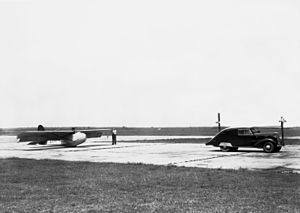|
Franklin PS-2
The Franklin PS-2 is an American, high-wing, strut-braced, single seat, glider that was designed by R. E. Franklin and produced by the Franklin Glider Corporation starting in 1930.[1][2] Design and developmentThe prototype PS-2 was the 50-foot (15 m) wingspan Texaco Eaglet, flown in 1930. The production PS-2 had shorter 36 ft (11.0 m) wings.[1][2] The PS-2 is constructed with a steel tube fuselage and a wooden wing, all covered in doped aircraft fabric covering. The wings lack spoilers of other glide-path control devices and are supported by dual, parallel struts. The landing gear is a fixed monowheel and a skid.[1][2] Operational history The prototype Eaglet performed a number of long tows, including one flown by Frank Hawks from California to Elmira, New York in 1930[3] and is now in the National Air and Space Museum.[1][2] In 1934, the PS-2 was the glider of choice for the Lustig Skytrain experiment. The concept was to tow three gliders in tandem, taking off from New York City and releasing one each over Philadelphia, Baltimore and Washington, D.C. The gliders were piloted by Jack O'Meara, PS-2 designer R.E. Franklin and Stan Smith. The Skytrain was intended to be a proof-of-concept for a future airline service, but was not pursued. The PS-2 was also used in 1934 for a United States Navy primary flight training experiment in Pensacola, Florida, designed by Ralph Barnaby[1][2] The PS-2 was also flown by many early glider pilots including Richard Chichester du Pont, Warren Eaton, Floyd Sweet and Stan Smith.[1][2] In 1983, two were reported as being still flown and one was under restoration by the designer's son, Chuck Franklin.[2] The Federal Aviation Administration had seven PS-2s registered in March 2011, including the Franklin-Stevens PS-2.[4] Variants
Aircraft on display
Specifications (PS-2)Data from Sailplane Directory and Soaring[1][2] General characteristics
Performance
See also
References
External linksWikimedia Commons has media related to Franklin PS-2. |
||||||||||||||||||||
